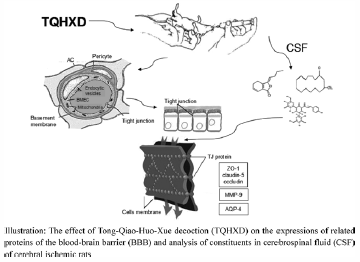- 著者
- Lili Li Ning Wang Qizhong Jin Qian Wu Yafang Liu Yan Wang
- 出版者
- The Pharmaceutical Society of Japan
- 雑誌
- Chemical and Pharmaceutical Bulletin (ISSN:00092363)
- 巻号頁・発行日
- vol.65, no.11, pp.1004-1010, 2017-11-01 (Released:2017-11-01)
- 参考文献数
- 35
- 被引用文献数
- 17 20
Tong-Qiao-Huo-Xue Decoction (TQHXD) is a classical prescription in traditional Chinese medicine treating blood stagnation in the head and facial channels, especially cerebral ischemia. We investigate the effect of TQHXD on the expressions of related proteins of the blood–brain barrier (BBB) and analysis of constituents in the cerebrospinal fluid (CSF) on cerebral ischemic model rats. Here, we demonstrate that TQHXD protected the hippocampus neurons, reduced the opening of tight junction (TJ) and decreased the permeability of BBB by up-regulating ZO-1, occludin, claudin-5 expressions, down-regulating aquaporin-4 (AQP-4) and matrix metalloproteinase-9 (MMP-9) expressions. Meanwhile, we detected Muscone, ligustilide and hydroxysafflor yellow A in CSF on cerebral ischemic model rats. These compounds could be identified as the main active ingredients of TQHXD on protecting the damaged BBB. These results suggest that TQHXD could act as a potential neuroprotective agent against BBB damage for cerebral ischemia.
- 著者
- Jing Lin Jun Zhu Yan Wang Na Zhang Hans-Jürgen Gober Xuemin Qiu Dajin Li Ling Wang
- 出版者
- International Research and Cooperation Association for Bio & Socio-Sciences Advancement
- 雑誌
- BioScience Trends (ISSN:18817815)
- 巻号頁・発行日
- vol.11, no.5, pp.496-506, 2017-10-31 (Released:2017-11-20)
- 参考文献数
- 99
- 被引用文献数
- 19 67
Postmenopausal osteoporosis is a systemic metabolic skeletal disease generally ascribable to a dearth of estrogen. Whether traditional Chinese medicine is effective in management of postmenopausal osteoporosis remains unclear. This article reviews the experimental evidence of both in vitro and in vivo preclinical studies with the theme of the application of Chinese single herbs and active ingredients in postmenopausal osteoporosis. It includes three single herbs (Herba Epimedium, Rhizoma Drynariae, and Salvia miltiorrhiza) and eight active ingredients (saikosaponins, linarin, echinacoside, sweroside, psoralen, poncirin, vanillic acid, and osthole). The experimental studies indicated their potential use as treatment for postmenopausal osteoporosis and investigated the underlying mechanisms including osteoprotegerin/receptor activator of nuclear factor κB ligand (OPG/RANKL), extracellular-signal-regulated kinase/c-Jun N terminal kinase/mitogen-activated protein kinase (ERK/JNK/MAPK), estrogen receptor (ER), bone morphogenetic protein (BMP), transforming growth factor (TGF)-β, Wnt/β-catenin, and Notch signaling pathways. This review contributes to a better understanding of traditional Chinese medicine and provides useful information for the development of more effective anti-osteoporosis drugs.
- 著者
- Tao YANG Fang ZHU Tianxiao ZHOU Jianzhong CAO Yibo XIE Meiyi ZHANG Yan WANG Dong-Sheng CAO Qinlu LIN Lin ZHANG
- 出版者
- (社)日本分析化学会
- 雑誌
- Analytical Sciences (ISSN:09106340)
- 巻号頁・発行日
- vol.33, no.2, pp.191-196, 2017-02-10 (Released:2017-02-10)
- 参考文献数
- 43
- 被引用文献数
- 7
This study aimed to develop a label-free, sensitive, selective, and environment-friendly fluorescent peptide probe His-His-Trp-His (HHWH) for determining the concentration of copper ion (Cu2+) in aqueous solutions. The results demonstrated that the designed HHWH has a high selectivity and sensitivity for monitoring the concentration of free Cu2+ via quenching of the probe fluorescence upon a binding of Cu2+. The fluorescence intensity of the HHWH had a linear relationship with the concentration of Cu2+ between 10 nM and 10 μM, and the detection limit was 8 nM. Furthermore, HHWH could be regenerated with sulfide ions at least five times. The concentrations of Cu2+ in three different real water samples were detected using this probe, and the results were consistent with the one detected using an atomic absorption spectrometer. Thus, HHWH can be used as an accurate and feasible fluorescent peptide probe for detecting Cu2+ in aqueous solutions.
- 著者
- Xinyu Li Yan Wang Kun Wang Yonggui Wu
- 出版者
- International Research and Cooperation Association for Bio & Socio-Sciences Advancement
- 雑誌
- BioScience Trends (ISSN:18817815)
- 巻号頁・発行日
- pp.2018.01009, (Released:2018-04-19)
- 参考文献数
- 36
- 被引用文献数
- 31
Paeoniflorin is the main bioactive components of the root of P.lactiflora Pall., and has been widely used as an anti-inflammation and immunomodulatory agent. However, the effect and mechanisms of Paeoniflorin in diabetic nephropathy (DN) remains to be elucidated. In the present study, streptozotocin (STZ)-induced type 1 diabetic mice model was used to investigate the protective effect of Paeoniflorin and the role of the Janus kinase (JAK) 2/signal transducer (STAT) 3 signaling pathway on DN. After treatment with Paeoniflorin at a dose of 25, 50 and 100 mg/kg once a day for 12 weeks, both the functional and histological damage to diabetic mice kidney had been attenuated significantly. Additionally, these reno-protective effects were associated with alleviating macrophage infiltration and inflammatory factors expression as well as suppression of the JAK2/STAT3 signaling pathway. These data reveal that Paeoniflorin attenuates renal lesions in diabetic mice and these protective effects may be associated with the prevention of macrophage infiltration and inhibition of the JAK2/STAT3 signaling pathway.
